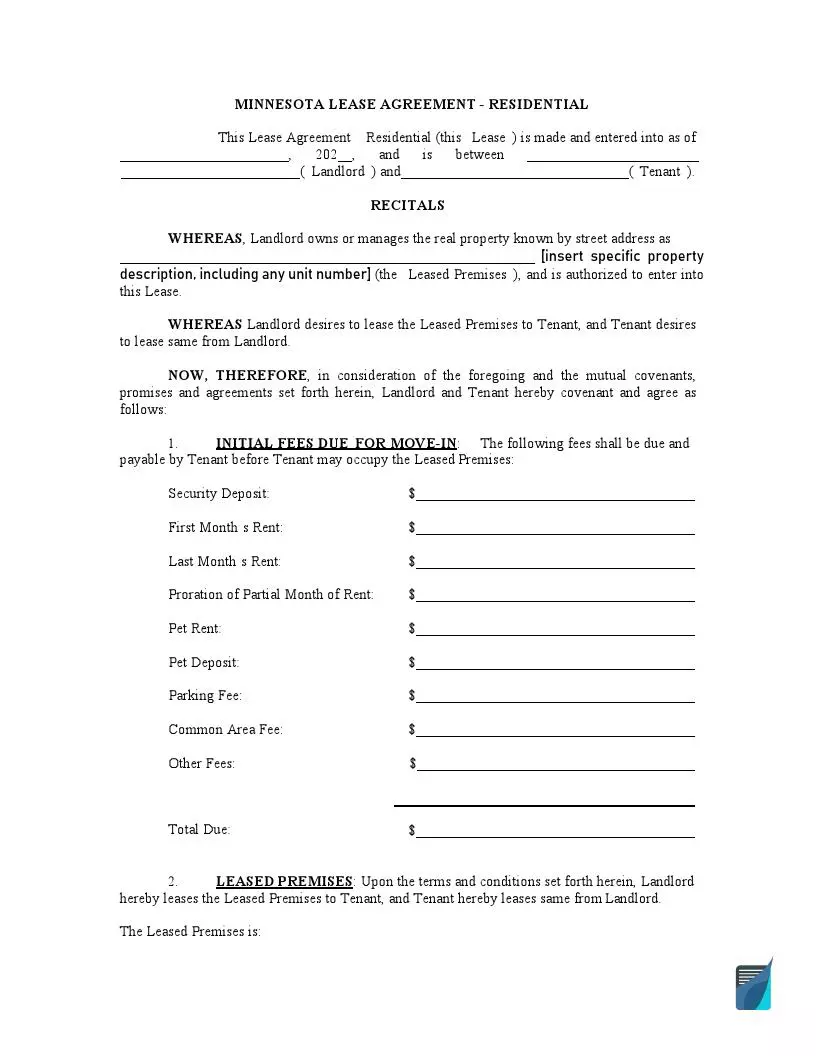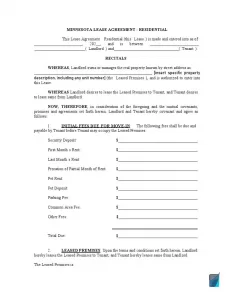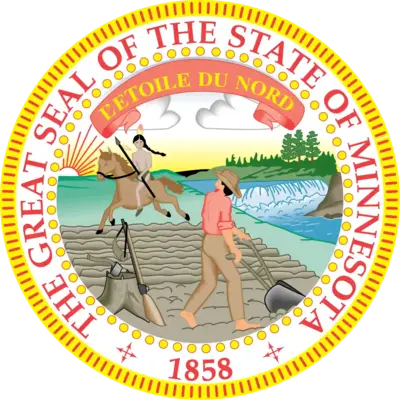Minnesota Rental Lease Agreement Forms
In the United States, the Lease (Rental) Agreement serves as legal evidence that an individual (or an entity) has granted another individual (or entity) permission to occupy the premises under specific terms and conditions. The rental agreement contains personal information about the tenants, other occupants, the landlord, a detailed description of the premises, the monthly rent both parties agree upon, and further details.
There is a list of the most important definitions mentioned in the paper:
- Controlled substance. Illegal substances, including distilled spirits, wine, tobacco, and others.
- The person responsible for the premises due to owning this real property.
- A document that describes the terms and conditions of the legal agreement upon tenancy.
- An individual, corporation, partnership.
- The official person authorized to check the condition of the property.

Build Your Document
Answer a few simple questions to make your document in minutes
Save and Print
Save progress and finish on any device, download and print anytime
Sign and Use
Your valid, lawyer-approved document is ready
Minnesota Laws and Lease Requirements
As the document is of significant importance, there are a number of conditions to keep to.
Only those tenants and occupants indicated in the document are allowed to reside in the premises, transmitting certain monetary funds to the landlord on the date mentioned in the paper every month. When they fail to do so, the landlord possesses the right to request the late fee.
Security Deposit
Security deposit is the amount of money paid to the landlord when moving into the premises in order to keep the place protected from damage and other undesirable situations. The deposit might be used to cover the tenant’s fee when they fail to pay monthly rent or to return the premises to its original condition if needed. Under other circumstances, the deposit is paid back to the tenant within 21 days after the agreement is no longer effective.
Rights and Responsibilities
The landlord promises to provide the tenant with the real estate fit for residency, renovate and repair the place if necessary, and keep the premises up to code.
The tenant is obliged to:
- Keep the premises safe and free from any damage.
- Remove no fixtures.
- Not paint the premises without the landlord’s written consent.
- Not disturb other persons’ peace and quiet.
- Use the premises only as a private residence.
Smoking might be either allowed or prohibited on the premises depending on the landlord’s choice. There is a corresponding box to check to indicate the attitude of the landlord.
Termination of Agreement
The contract may be terminated at any time. For doing so, the party that initiates termination should provide written notice. When vacating, the tenant should leave the place not later than 11:59 PM of the ending date. If the tenant stays at the premises for any longer, the lease is prolonged, and monthly payment should be transmitted.
Popular Local Rental Lease Agreement Forms
- Oregon (OR) rental lease agreement form and laws
- Massachusetts (MA) lease agreement form and guide
- Illinois lease sample
- Ohio (OH) rental agreement guide
- Maryland rental lease agreement form and guide
- MI rental lease agreement for download
- California rental agreement guidelines
- New Mexico (NM) lease for download
Assaulting Behavior
According to the §504B.305 of the law of Minnesota, both parties are not allowed to keep unlawful substances at the place. It is prohibited to use the premises for illegal manufacture, sell, barter, or delivery of narcotics as well. Prostitution or related activities must not occur on the premises.
Lead Paint Warning and Disclosure Info
If the house was built before the year 1978, it might contain dangerous lead-based paint. The landlord has to provide true and correct information about the hazards they are aware of. If there have been reports concerning the issue, they should be indicated as well. Both the tenant and the private agent have to admit they have received information about this and append their signatures.
Premises Destroyed and Unfit for Occupancy
If in the course of time, the premises get totally unfit with no tenant’s neglect, the lease is ended (both landlord or tenant may initiate the end of the agreement). However, if the premises get damaged and impossible to live in through the tenant’s fault, the landlord should end the lease and give written notice to the tenant.
The premises have to be inspected before moving in and found to be in the condition described in the document. If the tenant is satisfied with the premises and the terms of the deal, while the landlord states to have no additional terms and requirements, both parties should sign the paper, affirming to have come to an agreement.
Minnesota Rental Lease Agreement Form Details
| Document Name | Minnesota Rental Lease Agreement Form |
| Other Names | MN Rental Lease, Minnesota Residential Lease Agreement |
| Relevant Laws | Minnesota Statutes, Chapter 504B |
| Security Deposit Amount | No limit |
| Security Deposit Return | Three (3) weeks from termination date |
| Avg. Time to Fill Out | 18 minutes |
| # of Fillable Fields | 119 |
| Available Formats | Adobe PDF |


Try out our document builder to customize any template available on FormsPal to your requirements. Here’s a group of some other widely-used Minnesota forms we offer.
Other Rental Lease Agreement Forms by State
